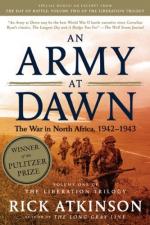
|
| Name: _________________________ | Period: ___________________ |
This test consists of 15 multiple choice questions and 5 short answer questions.
Multiple Choice Questions
1. What new piece of highly effective German equipment was introduced in the battle of November 26th in the Tine Valley?
(a) The Bazooka.
(b) Rocket launchers on tracks.
(c) Wing mounted anti-personnel guns.
(d) An armor peircing long-barreled 75mm gun mounted on Panzers.
2. What was General Giraud's stated expectation upon reaching Gibraltar?
(a) To assume the responsibility of preparing a beach assault in Normandy.
(b) To be shipped directly to North Africa where he would inspire the Vichy French forces to join the Allied cause.
(c) To be awarded the rank of Deputy Commander-in-Chief.
(d) To assume command of all Allied forces.
3. According to the author, what makes Medjez-el-Bab a strategically important location?
(a) Located on a high plateau, it is easily defended.
(b) It has several large airfields and whomever controls the air, controls North Africa.
(c) It is 30 miles from Tunis and straddles the Medjerda River.
(d) Through it is the sole land route to Tunis.
4. What did Allen determine to do instead of following Colonel Greer's suggestion?
(a) Bifurcate the city with tanks and take the high ground first.
(b) Bypass St. Cloud.
(c) Use air support and cover of night to take out specific enemy installations.
(d) Concentrate his troops and make one desperate last push.
5. In the winter of 1942, which Nation proved the dominant Air force in North Africa?
(a) America.
(b) France.
(c) Britain.
(d) Germany.
6. The shortages of necessities at the outset of Anderson's push East, inspired this quote: "The most important thing is never to be apart from your:
(a) Unit.
(b) Spoon.
(c) Rations.
(d) Radio.
7. What was operation WATCHTOWER?
(a) A pre-emptive strike by the Royal Air Force against North African Axis bases.
(b) The name of the original U.S. plan to attack Germany through France.
(c) A covert mission to convince Vichy France to join the Allied cause.
(d) The first Allied counter-offensive against Japan at Guadalcanal.
8. North Africa is where the Allies agreed on a policy of:
(a) Unconditional surrender.
(b) Military autonomy.
(c) Detente.
(d) Blitzkrieg.
9. Who wrote: "Would God I might die with my sword in hand / Ringed by dead foes all around."
(a) Ike.
(b) Commander Terry Allen.
(c) Brigadier General Ted Roosevelt.
(d) General George Patton.
10. According to Rear Admiral Bennett, the RESERVIST plan was:
(a) "A moral building excercise."
(b) "Excessive."
(c) "Suicidal and absolutely unsound."
(d) "Strategically unimportant to winning the war."
11. What is Brigadier General Truscott quoted as learning, perhaps in relation to his conflict in Mehdia?
(a) "Nothing undoes a good strategy like French snipers."
(b) "Luck is worth a division."
(c) "There is no winning, there is only moving on."
(d) "No matter how large the force engaged, every battle is made up of small actions by individuals and small units."
12. What was operation RESERVIST?
(a) A bombing attack from Gibraltar bases on Axis ports in North Africa.
(b) A British plan to forestall the sabotage of Oran's port.
(c) A clandestine mission launched by Patton.
(d) An Allied plan that spread forces across north Tunisia.
13. What written warning from superiors did Commander Terry Allen burn?
(a) That the French would show resolve in repelling the attack.
(b) That the French should not be considered hostile.
(c) That the British planned to outflank him.
(d) That aircover would not be provided.
14. According to General Patten, it was his expectation of an officer to:
(a) Defer to their British counterparts.
(b) Lead from the rear and let the troops do the fighting.
(c) Spread chaos through the destruction of civilian property.
(d) Move ahead.
15. What was the plan for integrating U.S. units into British lead military organizations?
(a) New U.S. troops were sent to England for specialist training.
(b) Units would be on a four week rotation.
(c) No plan existed.
(d) Select troops were permanently assigned.
Short Answer Questions
1. What encounter occurred on November 26th, one day after the successful raid on the airport in Djedeida, between newly outfitted Panzers and John Water's First Battalion, and is considered a 'draw' by the author?
2. What political arrangement with the French particularly caused a public outcry in both the U.S. and Britain?
3. What excuse did Patton cite for disobeying orders regarding the planned bombardment of Casablanca.
4. What plan did Colonel Frank Greer suggest that was countermanded by Terry Allen?
5. Whose personal credo is: "Always do whatever you can to keep your superior from making a mistake."
|
This section contains 803 words (approx. 3 pages at 300 words per page) |

|




